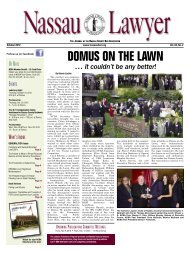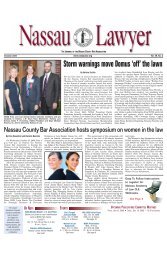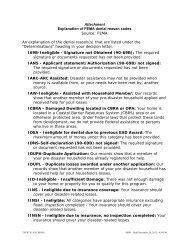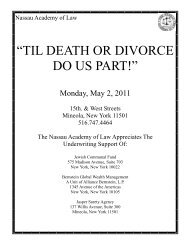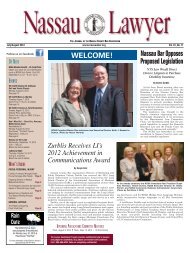394 B.R. 721 Page 12394 B.R. 721, 50 Bankr.Ct.Dec. 192(Cite as: 394 B.R. 721)ficient to state an intentional fraudulent transfer claim.E.g., Fed. Nat'l Mortgage Ass'n v. Olympia MortgageCorp., No. 04 CV 4971(NG)(MDG), 2006 WL 2802092,at *9 (E.D.N.Y. Sept. 28, 2006)(dismissing intentionalfraudulent transfer claims that aggregated and lumped aseries <strong>of</strong> cash transfers made over a three to five year periodand failed to identify how many transfers were beingchallenged or the specific dates or amounts <strong>of</strong> those transfers);Gindi v. Silvershein, No. 93 Civ. 8679(LLS), 1995WL 347397, at *6 (S.D.N.Y. June 8, 1995)(dismissingintentional fraudulent transfer claim that alleged a series<strong>of</strong> non-specific transfers and obligations); Silverman v.K.E.R.U. Realty Corp. (In re Allou Distribs., Inc.), 379B.R. 5, 31-32 (Bankr.E.D.N.Y.2007)(dismissing claim <strong>of</strong>intentional fraudulent transfer <strong>of</strong> "millions <strong>of</strong> dollars"without specifying the source, dates or the amounts <strong>of</strong> thetransfers that the trustee was seeking to recover); Thalerv. Adler (In re Adler), 372 B.R. 572, 581(Bankr.E.D.N.Y.2007)(dismissing intentional fraudulenttransfer claim that did not "allege any specifics as to theamounts or dates" <strong>of</strong> cash deposits made by a debtor husbandinto his wifes bank account); cf. Sullivan v. Kodsi,373 F.Supp.2d 302, 306 (S.D.N.Y.2005)(denying motionto dismiss intentional fraudulent transfer claims challengingnon-specific transfers made to *734 a family trustbetween late 1997 and June 2000 on the ground that thefacts were "peculiarly within the opposing party's knowledge,"and several "badges <strong>of</strong> fraud" were present).[9] The allegations <strong>of</strong> actual fraudulent transfer directedagainst the Pre-Petition Banks fail to satisfy these requirements.The Amended Complaint does not identifyany specific transfer, transferor, [FN9] transferee, [FN10]or date <strong>of</strong> transfer. Instead, it challenges the "net" transfersin the amount <strong>of</strong> $175.3 million to the Fortgang Affiliatesbetween January 2003 and the Petition Date.Moreover, the focus on the aggregate "net" amount <strong>of</strong>transfers implies that some were repaid, undercutting theplaintiff's apparent theory that all <strong>of</strong> the Pre-Petition Bankloans were fraudulently reconveyed to the Fortgang Affiliates.(See 32)("Fabrikant funded the transfers to theFortgang Affiliates through these obligations that it in-from the Pre-Petition curred Banks.")FN9. There are two debtors in the case, but theAmended Complaint frequently lumps them together.FN10. The Fortgang Affiliates include 47 separateentities. The Amended Complaint lumpsthem together, without distinction, in Counts Ithrough IV.The allegations regarding the single SPM transfer arefree <strong>of</strong> most <strong>of</strong> these pleading deficiencies, but not all <strong>of</strong>them. MFS purchased $32 million <strong>of</strong> gold from SPM onJuly 7, 2006, and both debtors were liable for the purchaseprice. ( 37.) Some $22 million worth <strong>of</strong> the goldpurchased had already been delivered to the FortgangAffiliates. ( 38.) The Amended Complaint neverthelessfails to identify which Fortgang Affiliates were the transfereesor the dates <strong>of</strong> the transfers. [FN11] Hence, theclaim against SPM also fails to satisfy Rule 9(b). In light<strong>of</strong> this conclusion, it is unnecessary to reach the otherarguments raised by the defendants in support <strong>of</strong> theirmotions to dismiss this element <strong>of</strong> the plaintiff's collapsingclaim. [FN12]FN11. According to the Amended Complaint,the SPM merchandise was delivered to the FortgangAffiliates prior to the actual sale, and presumablyon consignment.FN12. The Court nevertheless rejects the argument,made at some length by certain defendants,that the plaintiff's claim is really one for aidingand abetting a breach <strong>of</strong> fiduciary duty which theplaintiff has failed to plead adequately, and inany event, lacks standing to assert. The plaintiffis not asserting any such claim.b. Constructive Fraud[10][11][12][13] The plaintiff may also satisfy its pleadingburden by alleging that the reconveyance <strong>of</strong> the loanproceeds and gold was constructively fraudulent understate or federal bankruptcy law. Under the New YorkDebtor & Creditor <strong>Law</strong> ("NYDCL"), which the partiescite, a person challenging a transfer <strong>of</strong> the debtor's propertyas constructively fraudulent must show that it wasmade without fair consideration and (1) the debtor wasinsolvent or was rendered insolvent by the transfer,NYDCL § 273, (2) the debtor was left with unreasonablysmall capital, id., § 274, [FN13] or (3) the debtor intendedor believed that it would incur debts beyond itsability to pay when the debts matured. Id., § 275. SharpInt'l, 403 F.3d at 53. Under NYDCL § 272,FN13. By its terms, § 274 ("unreasonably smallcapital") applies to conveyances but not obligations,and cannot be relied on to invalidate thedebtors' loan debt or guaranties to the Pre-Petition Banks. See Silverman v. Paul's Land-© 2009 Thomson Reuters. No Claim to Orig. US Gov. Works.
394 B.R. 721 Page 13394 B.R. 721, 50 Bankr.Ct.Dec. 192(Cite as: 394 B.R. 721)mark, Inc. (In re Nirvana Rest. Inc.), 337 B.R.495, 508 (Bankr.S.D.N.Y.2006). Furthermore,the delivery <strong>of</strong> collateral to secure a nonavoidabledebt or obligation constitutes a transfersupported by "fair consideration" that cannot beset aside under the NYDCL. See id. at 502.*735 Fair consideration is given for property, or obligation,a. When in exchange for such property, or obligation, asa fair equivalent therefor, and in good faith, property isconveyed or an antecedent debt is satisfied, [FN14] orFN14. The "good faith" aspect <strong>of</strong> "fair consideration"is an "elusive concept" that "is hard to locate... in a statute in which the issue <strong>of</strong> intent isirrelevant." Sharp Int'l, 403 F.3d at 54 (internalquotation marks and citation omitted). Here, theAmended Complaint essentially alleges thatCharles and Matthew Fortgang siphoned moneyand property from the debtors, who they controlled,and transferred the siphoned assets to theFortgang Affiliates, who they also controlled.Lack <strong>of</strong> good faith would presumably existwhere the transferors and transferees are affiliatesengaged in the sort <strong>of</strong> scheme alleged in theAmended Complaint. The Amended Complaintalso alleges that MFS was using some <strong>of</strong> the Pre-Petition Bank debt to repay debts owed to theFortgang Affiliates while its own financial conditionwas deteriorating. ( 41.) Insider preferencesby an insolvent transferor, even whenmade to satisfy valid debts, lack good faith. SeeSharp Int'l, 403 F.3d at 54.b. When such property, or obligation is received ingood faith to secure a present advance or antecedentdebt in amount not disproportionately small as comparedwith the value <strong>of</strong> the property, or obligation obtained.The bankruptcy law contains similar provisions. Under §548(a)(1)(B), the trustee must demonstrate that within twoyears <strong>of</strong> the petition date, (1) the debtor transferred aninterest in property; (2) the debtor was (a) insolvent at thetime <strong>of</strong> the transfer or became insolvent as a result <strong>of</strong> thetransfer, (b) was engaged in business or was about to engagein business for which the debtor's remaining propertywas an unreasonably small capital, or (c) intended toincur or believed that it would incur debts beyond its abilityto pay as they matured, and (3) the debtor received lessthan a reasonably equivalent value in exchange for suchtransfer. "Good faith" is not an element <strong>of</strong> the plaintiff'spro<strong>of</strong> <strong>of</strong> "reasonably equivalent value" under the BankruptcyCode and the Uniform Fraudulent Transfer Act,see Unif. Fraudulent Transfer Act, § 4 cmt. 2 (2006); instead,good faith is an affirmative defense that the transfereemay raise but the plaintiff need not plead. Silvermanv. Actrade Capital, Inc. (In re Actrade Fin. Techs. Ltd.),337 B.R. 791, 802 (Bankr.S.D.N.Y.2005).[14][15] Rule 9(b) does not apply to claims sounding inconstructive fraudulent transfer, Id. at 801 (collectingcases), and allegations <strong>of</strong> a constructive fraudulent transferare subject to less rigorous pleading requirements. Theplaintiff need not provide specific facts to support its allegations,see Erickson v. Pardus, --- U.S. ----, 127 S.Ct.2197, 2200, 167 L.Ed.2d 1081 (2007), and Rule 8(a) onlyrequires that the allegations "give the defendant fair notice<strong>of</strong> what the plaintiff's claim is and the grounds uponwhich it rests." Swierkiewicz v. Sorema N.A., 534 U.S.506, 512, 122 S.Ct. 992, 152 L.Ed.2d 1 (2002)(quotingConley v. Gibson, 355 U.S. 41, 47, 78 S.Ct. 99, 2 L.Ed.2d80 (1957)). As a result, some <strong>of</strong> the same courts that rejectedthe non-particularized allegations <strong>of</strong> intentionalfraudulent transfers upheld the sufficiency <strong>of</strong> the constructivefraudulent transfer claims based on the sameallegations. E.g., Fed. Nat'l Mortgage Ass'n, 2006 WL2802092, at *9 (allegations that aggregated and lumped aseries <strong>of</strong> transfers made over a three to five year periodand failed to identify the number <strong>of</strong> transfers, the specificdates <strong>of</strong> the transfers or the amounts <strong>of</strong> the transfers "aresufficient to satisfy the notice pleading standard <strong>of</strong> Rule 8,but, [with one exception], not the heightened pleadingstandard <strong>of</strong> Rule 9(b)."); *736Gindi, 1995 WL 347397, at*5-6 (allegations that the debtor made or incurred a nonparticularizedseries <strong>of</strong> transfers and obligations weresufficient to survive a motion to dismiss under Rule12(b)(6) but insufficient under Rule 9(b)); see Court-Appointed Receiver for Lancer Mgmt. Group LLC v.169838 Canada, Inc., No. 05-60235-CIV. (KAM), 2008WL 2262063, at *3 (S.D.Fla. May 30, 2008)(Rule 8(a)does not require the pleader to "allege the particular transferswhich each <strong>of</strong> the [defendants] received," or the capacityin which the defendants received them); Sullivan,373 F.Supp.2d at 307-08 (denying motion to dismiss constructivefraudulent transfer claims challenging nonparticularizedtransfers made to a family trust betweenlate 1997 and June 2000).Here, the Amended Complaint alleges that the debtorstransferred over $175 million to the Fortgang Affiliates© 2009 Thomson Reuters. No Claim to Orig. US Gov. Works.
- Page 1 and 2:
Nassau Academy of LawCLE Live Class
- Page 3 and 4:
McKinney's Debtor and Creditor Law
- Page 5 and 6:
McKinney's Debtor and Creditor Law
- Page 7 and 8:
McKinney's Debtor and Creditor Law
- Page 9 and 10:
McKinney's Debtor and Creditor Law
- Page 11 and 12:
McKinney's Debtor and Creditor Law
- Page 13 and 14:
McKinney's Debtor and Creditor Law
- Page 15 and 16:
McKinney's Debtor and Creditor Law
- Page 17 and 18:
McKinney's Debtor and Creditor Law
- Page 19 and 20:
BAKER & HOSTETLER LLP45 Rockefeller
- Page 21 and 22:
usiness of defendant Bernard L. Mad
- Page 23 and 24:
BACKGROUND, THE TRUSTEE, AND STANDI
- Page 25 and 26:
Madoff who received fraudulent tran
- Page 27 and 28:
ased on fictitious profits and for
- Page 29 and 30:
28. BLMIS funds were also used to p
- Page 31 and 32: Madoff, and her niece, Shana Madoff
- Page 33 and 34: 42. Ruth Madoff was never an employ
- Page 35 and 36: FIRST CAUSE OF ACTIONTURNOVER AND A
- Page 37 and 38: 66. At the time of each of the Two-
- Page 39 and 40: Transfers; (b) directing that the S
- Page 41 and 42: EIGHTH CAUSE OF ACTIONUNDISCOVERED
- Page 43 and 44: TENTH CAUSE OF ACTIONDISALLOWANCE O
- Page 45 and 46: 111. Mrs. Madoff benefited from the
- Page 47 and 48: WHEREFORE, the Trustee respectfully
- Page 49 and 50: 2(c)(3): (a) preserving the Subsequ
- Page 51 and 52: 302 B.R. 760 Page 1302 B.R. 760(Cit
- Page 53 and 54: 302 B.R. 760 Page 3302 B.R. 760(Cit
- Page 55 and 56: 302 B.R. 760 Page 5302 B.R. 760(Cit
- Page 57 and 58: 302 B.R. 760 Page 7302 B.R. 760(Cit
- Page 59 and 60: 302 B.R. 760 Page 9302 B.R. 760(Cit
- Page 61 and 62: 302 B.R. 760 Page 11302 B.R. 760(Ci
- Page 63 and 64: 302 B.R. 760 Page 13302 B.R. 760(Ci
- Page 65 and 66: 302 B.R. 760 Page 15302 B.R. 760(Ci
- Page 67 and 68: 302 B.R. 760 Page 17302 B.R. 760(Ci
- Page 69 and 70: 302 B.R. 760 Page 19302 B.R. 760(Ci
- Page 71 and 72: 394 B.R. 721 Page 1394 B.R. 721, 50
- Page 73 and 74: 394 B.R. 721 Page 3394 B.R. 721, 50
- Page 75 and 76: 394 B.R. 721 Page 5394 B.R. 721, 50
- Page 77 and 78: 394 B.R. 721 Page 7394 B.R. 721, 50
- Page 79 and 80: 394 B.R. 721 Page 9394 B.R. 721, 50
- Page 81: 394 B.R. 721 Page 11394 B.R. 721, 5
- Page 85 and 86: 394 B.R. 721 Page 15394 B.R. 721, 5
- Page 87 and 88: 394 B.R. 721 Page 17394 B.R. 721, 5
- Page 89 and 90: 394 B.R. 721 Page 19394 B.R. 721, 5
- Page 91 and 92: 394 B.R. 721 Page 21394 B.R. 721, 5
- Page 93 and 94: 397 B.R. 642 Page 2397 B.R. 642(Cit
- Page 95 and 96: 397 B.R. 642 Page 4397 B.R. 642(Cit
- Page 97 and 98: 397 B.R. 642 Page 6397 B.R. 642(Cit
- Page 99 and 100: 397 B.R. 642 Page 8397 B.R. 642(Cit
- Page 101 and 102: 397 B.R. 642 Page 10397 B.R. 642(Ci
- Page 103 and 104: 397 B.R. 642 Page 12397 B.R. 642(Ci
- Page 105 and 106: 397 B.R. 642 Page 14397 B.R. 642(Ci
- Page 107 and 108: 443 F.3d 180 Page 2443 F.3d 180(Cit
- Page 109 and 110: 443 F.3d 180 Page 4443 F.3d 180(Cit
- Page 111 and 112: 443 F.3d 180 Page 6443 F.3d 180(Cit
- Page 113 and 114: 443 F.3d 180 Page 8443 F.3d 180(Cit
- Page 115 and 116: 443 F.3d 180 Page 10443 F.3d 180(Ci
- Page 117 and 118: 443 F.3d 180 Page 12443 F.3d 180(Ci
- Page 119 and 120: Page 2257 A.D.2d 526, 684 N.Y.S.2d
- Page 121 and 122: Page 4257 A.D.2d 526, 684 N.Y.S.2d
- Page 123 and 124: Page 6257 A.D.2d 526, 684 N.Y.S.2d
- Page 125 and 126: 770 N.Y.S.2d 421 Page 22 A.D.3d 780
- Page 127 and 128: Page 14 A.D.3d 495, 773 N.Y.S.2d 71
- Page 129: Page 34 A.D.3d 495, 773 N.Y.S.2d 71
- Page 132 and 133:
780 N.Y.S.2d 409 Page 29 A.D.3d 553
- Page 134 and 135:
Page 134 A.D.3d 231, 824 N.Y.S.2d 3
- Page 136 and 137:
Page 334 A.D.3d 231, 824 N.Y.S.2d 3
- Page 138 and 139:
Page 2991 F.2d 31(Cite as: 991 F.2d
- Page 140 and 141:
Page 4991 F.2d 31(Cite as: 991 F.2d
- Page 142 and 143:
Page 6991 F.2d 31(Cite as: 991 F.2d
- Page 144 and 145:
FRAUDULENT TRANFERENCESRonald M. Te
- Page 146 and 147:
Nursing home case_ Transfer of pers
- Page 148 and 149:
Sections 548 and 544 work in concer
- Page 150 and 151:
U.S. Supreme CourtBFP v. Resolution
- Page 152 and 153:
example, from net 15 to COD; or cha
- Page 154 and 155:
Bankruptcy Code Section§ 548. Frau
- Page 156:
Ron Terenzi is a founding partner a



